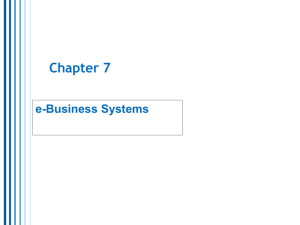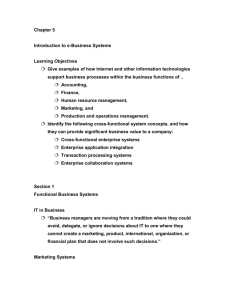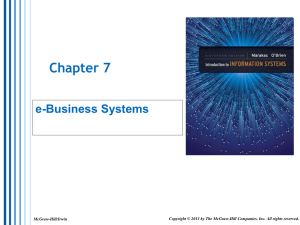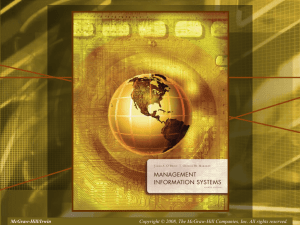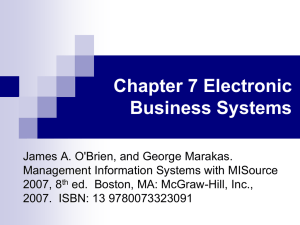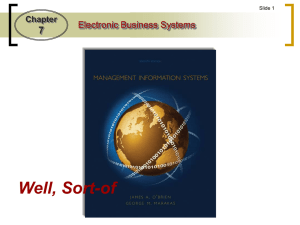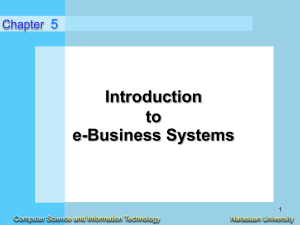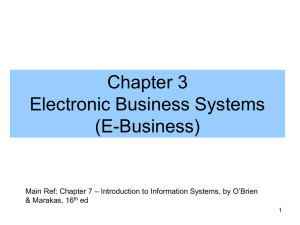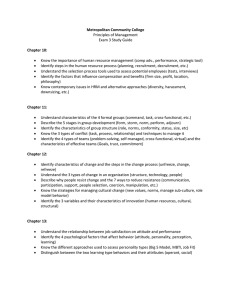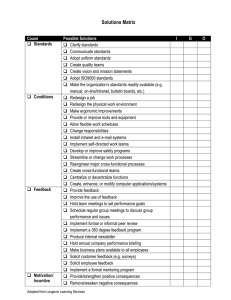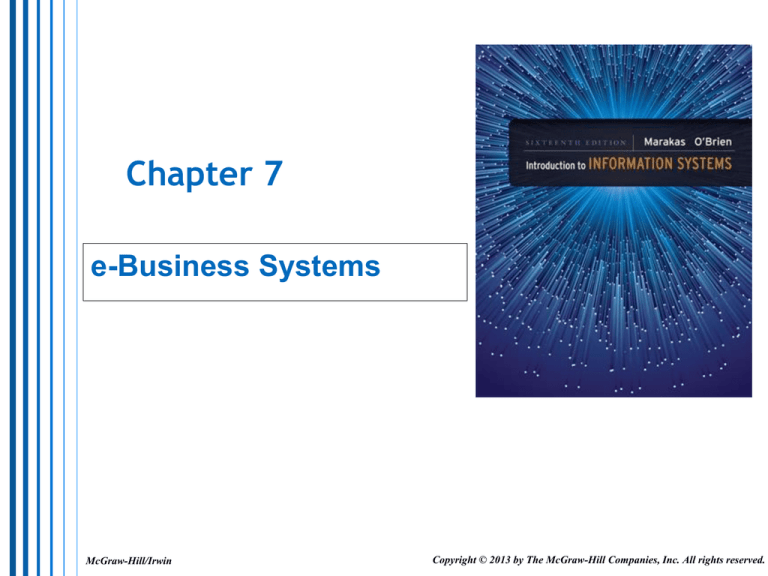
Chapter 7
e-Business Systems
McGraw-Hill/Irwin
Copyright © 2013 by The McGraw-Hill Companies, Inc. All rights reserved.
Learning Objectives
Identify the following cross-functional
enterprise systems, and give examples of how
they can provide significant business value to a
company:
Enterprise application integration
Transaction processing system
Enterprise collaboration system
7-2
Learning Objectives
Give examples of how Internet and other
information technologies support business
processes within the business functions of
accounting, finance, human resource
management, marketing, and production and
operations management.
7-3
Section 1
E-Business Systems
7-4
I. Introduction
e-business is much broader than ecommerce, using the Internet for any
type of business activity
7-5
II. Cross-Functional Enterprise Applications
Reengineer/improve business activities
by crossing boundaries of traditional
business functions
Enterprise Application Architecture –
overview of major cross-functional
enterprise applications and their
interrelationships
7-6
IV. Transaction Processing Systems
Handles/records daily business activities
(transactions)
Transaction – anything that occurs during
daily business of which a record must be
kept
Online transaction Processing Systems –
capture and process transactions
immediately, in real time
7-7
V. Enterprise Collaboration Systems (ECS)
Cross-functional IS help users to:
Communicate – share information
Coordinate – organize work efforts and
resources
Collaborate – work together on projects
7-8
V. Enterprise Collaboration Systems (ECS)
Electronic Tools Enhance Enterprise
Collaboration
7-9
Section 2
Functional Business Systems
7-10
II. Marketing Systems
IS that aid in planning, promotions and
sale of existing products in existing
markets
Interactive Marketing – customer-focused
two-way transactions between a firm and
its (potential) customers
Sales Force Automation – connect the sales
force to the Internet, intranets, and
extranets
7-11
III. Manufacturing Systems
Support the production/operations function
Computer-Integrated Manufacturing
Goal: to create flexible, agile, manufacturing
processes that efficiently produce highest quality
products
3 Objectives:
Simplify (reengineer) production processes
Automate – with computers, machines, robots
Integrate – tie together all production and support
processes with networks, cross-functional software,
and other IT
7-12
IV. Human Resource Systems
Human Resource Information Systems (HRIS)
support:
Planning to meet personnel needs
Development employee to their full potential
Control personnel policies and programs
HRM and the Internet – Internet is a major
force for change in HRM
HRM and Corporate Intranets – Intranets allow
firms to provide services to customers and
employees
7-13
V. Accounting Systems
The oldest and most widely used IS in
business; emphasize legal/historical record
keeping accurate financial statements
6 operational accounting systems:
Order Processing – capture/process orders, create
data for inventory control and accounts receivable
Inventory Control – process data reflecting changes
in inventory, provides shipping/reorder information
Accounts Receivable – record amounts owed by
customers, produce customer invoices/statements
and credit management reports
7-14
VI. Financial Management Systems
Support decisions concerning:
Financing a business – determine financing needs
Allocation and control of financial resources
Capital Budgeting – evaluate profitability and financial
impact of proposed capital expenditures
Financial Planning – evaluate present and projected
financial performance
7-15

